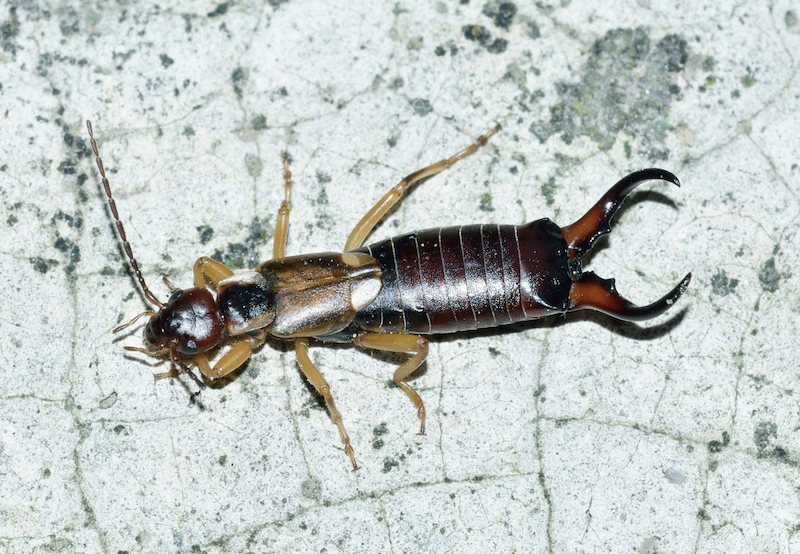If you’ve gotten them in your house, you’re probably wondering how to get rid of earwigs. In that case, you need to learn everything you can about them, their habits, and what attracts them to you to keep them away.
So, what attracts earwigs? The answer can go a long way towards keeping them from getting inside your home.
Read on to learn more about earwigs, what they like, and what can attract them to your home.
Identifying an Earwig
Earwigs are an insect easily identifiable by their long abdomen, pincer-like cerci, and membranous wings. Their pincers make them perfect for catching other insects and eating them. Being most active at night, these bugs are attracted to moist areas with plenty of vegetation.
Earwigs generally gather in groups at the base of trees and mulch piles. They may also be seen around porch lights, moisture in the basement, and window frames. They have been known to eat from decaying material and plants and sometimes other animals that live in the same area.
Factors That Attracts Earwigs
Earwigs are insects that are attracted to certain conditions and factors. Based on the type of earwig, moisture and dampness are particularly attractive.
By understanding what attracts earwigs, you can prevent them from invading your home and garden. Here are some top factors that attracts earwigs that people needs to be aware of:
Food Sources
Earwigs prefer areas near food sources, so that they can be found near vegetable gardens and old tree stumps. Earwigs are attracted to ripe fruit because it provides a great source of sugar and moisture. They feed on other insects and decaying organic matter, such as dead plants and animals.
Environment and Climate Factors
Drawn to wearing organic matter, they often inhabit the walls, eaves, and other sheltered places of buildings. Earwigs also thrive in greenhouses and other areas with constant temperature and humidity.
Aggregation Pheromone
These are biological chemicals essential in attracting earwigs, which are considered a pest in many gardens and homes. Aggregation pheromones are caused by the production and release of certain substances by the earwig, and they act as attractants for other earwigs in the vicinity.
These odorless pheromones typically trigger earwig aggregation but are still detectable due to the size of the droplets. These pheromones may also communicate between earwigs, telling them such things as food availability, location, and nesting sites.
Rotting Wood
Rotting wood provides a dark, damp shelter ideal for an earwig’s needs. It can quickly drill a hole with its long pincers to feed and develop into a larva or an adult.
Organic matter such as wood can provide ideal conditions for food production, making rotten wood a perfect habitat for earwigs. The earwigs will hide beneath the bark, feed on various food sources, and lay their eggs.
Exterior Lighting
Exterior lighting emits a wavelength of light that an earwig detects, which draws them in. Bright, white, and yellow lights attract them more, as they think it will make it easier to find prey at night. Earwigs are drawn to small areas and crevices, so exterior lighting will be extra appealing since it can lead them to sheltered spots and hideaways.
In particular, full-spectrum lightings, such as halogens and LEDs, tend to attract the most earwigs. Exterior lighting attracts earwigs because it provides them with a well-lit area to move about in and a warm place to remain active.
Preventive Solutions
The most effective way to prevent earwigs from getting in your home is to keep the outside of your house clutter-free. Remove any leaf piles, damp wood piles, and other rotting matter. Doors and windows should be fitted with tight-fitting weather-stripping and door thresholds.
It is essential to ensure your foundation perimeter is free of gaps and cracks that could encourage the entry of earwigs and regularly inspect and repair any deficiencies. Keep grass and other vegetation cut back from your foundation walls and slabs, as earwigs are often attracted to tall grass or overgrown vegetation.
If you have soil near your foundation that is consistently wet or overly damp, consider adding some drainage or aeration to make the soil drier. Consider installing a perimeter insecticide. It is to provide a repellent barrier and prevent earwigs from entering your home.
Natural repellents such as diatomaceous earth and cedar wood chips can help deter earwigs. Diatomaceous earth is a natural insecticide composed of silica and other minerals that will physically cut and dry out an earwig’s body. Cedar wood chips contain natural oils and chemicals that naturally repel earwigs.
A regular cleaning regimen can also help reduce earwig populations by removing potential habitats created by decaying matter. Ensure all vents, exhaust fans, and pipes are properly sealed. To further reduce the likelihood of an earwig infestation, look for an earwig pest control. Professional extermination companies have the right equipment and experience to deal with the infestation thoroughly.
Understanding What Attracts Earwigs
In conclusion, earwigs are attracted to areas with high moisture and decaying vegetation. Providing proper drainage and avoiding attractants such as compost piles or another moist environment can help keep these pests away from your home.
Keeping moisture levels low and food sources limited can go a long way in keeping these creepy crawlers away. Take the necessary steps to avoid what attracts earwigs and enjoy a bug-free home.
If you enjoy this article, check out our blog for more exciting content!


